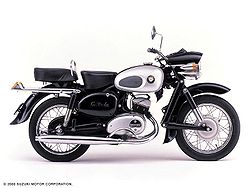Difference between revisions of "Suzuki Colleda"
| Line 1: | Line 1: | ||
[[Image:1956 Colleda 250TT 800.jpg|250px| | [[Image:1956 Colleda 250TT 800.jpg|250px|]] | ||
You couldn't find any Suzuki stickers or emblems on the motorcycles Suzuki built on the early models. No, the early models were given the name Colleda and the famous Suzuki ”S” appeared for the first time in 1959 and the Colleda brand name was replaced by Suzuki in the early 1960's, the T10 being the first non-Colleda. Here's some of the Suzuki's Colleda models from the fifties and early sixties. I will add more models here when I find suitable pictures and some facts. | You couldn't find any Suzuki stickers or emblems on the motorcycles Suzuki built on the early models. No, the early models were given the name Colleda and the famous Suzuki ”S” appeared for the first time in 1959 and the Colleda brand name was replaced by Suzuki in the early 1960's, the T10 being the first non-Colleda. Here's some of the Suzuki's Colleda models from the fifties and early sixties. I will add more models here when I find suitable pictures and some facts. | ||
Revision as of 22:22, 2 July 2006
 You couldn't find any Suzuki stickers or emblems on the motorcycles Suzuki built on the early models. No, the early models were given the name Colleda and the famous Suzuki ”S” appeared for the first time in 1959 and the Colleda brand name was replaced by Suzuki in the early 1960's, the T10 being the first non-Colleda. Here's some of the Suzuki's Colleda models from the fifties and early sixties. I will add more models here when I find suitable pictures and some facts.
You couldn't find any Suzuki stickers or emblems on the motorcycles Suzuki built on the early models. No, the early models were given the name Colleda and the famous Suzuki ”S” appeared for the first time in 1959 and the Colleda brand name was replaced by Suzuki in the early 1960's, the T10 being the first non-Colleda. Here's some of the Suzuki's Colleda models from the fifties and early sixties. I will add more models here when I find suitable pictures and some facts.
1954
Apparently the word "Colleda" means something like "This is it!" or "This is the one!" in Japanese. The Japanese use that word when they find something special (the best) they have been looking for. (Thanks, Takeshi!)
Suzuki Loom Manufacturing Company (SJK) presented the side-valve powered Colleda CO in May 1954, the first real motorcycle from Suzuki. The single-cylinder 90cc four-stroke engine developed four horsepower and ran quite smoothly, thanks to its heavy fly wheel, attached to ignition magneto.
No driver's license was needed at the time for riding the Colleda CO. The Japanese government had recently decided that no driver's license were longer needed to ride a bike with an 4-stroke engine up to 90cc or a 2-stroke engine up to 60cc. That explains rather well Suzuki's choice of engines for its first models on the market in 1954 - the Diamond Free motorized motorcycle with 58cc 2-stroke engine with 2 hp and the 90cc four-stroke with 4 hp.
The Colleda CO had a steel frame, telescopic front fork, shock absorbers on the rear wheel and coil spring-suspensioned seat. It had no turning lights but it did have a headlight and a rear light. It was the first Japanese motorcycle provided with a speedometer, built in the headlight. The built-in gearbox had three speeds. One source claim that the model had hydraulic brakes but I haven't been able to confirm this.
The rigid frame and luggage carrier made the bike suitable for carrying of goods. They say that the 90cc Colleda sounded more than it actually performed, but the ”sound effects” and the rigid construction made the bike quite popular among Japanese customers.
Engine type: 90 cc side-valve single cylinder four-stroke. 4 hp.
Three speeds, telescopic front forks and plunger rear suspension.
1955
It was not longer allowed to ride a 90cc four-stroke without a driver's license in 1955 and that naturally affected the sales figures in negative direction. The 90cc Colleda CO must be one of the absolute rarest motorcycles Suzuki ever built. The model was soon discontinued and replaced by the 125cc version. But the four-stroke machines at the time were not as reliable as the more simple two-stroke machines and soon Suzuki discontinued even the 125 model. All the forces were concentrated in developing two-stroke engines. It took actually over 20 years before Suzuki built four-strokes again, after an unsuccessful attempt of using Wankel rotary engines.
The four-stroke models got company by the 102cc Porter Free and 123cc ST during 1955. Both models were two-strokers with steel frame, telescopic front forks and plunger rear suspension, similar to their predecessors. All of the Colleda two-stroke engines used the conventional piston valve construction, the rotary (reed) valve engines came much later.
The ST was the most successful of the models. It was a simple and affordable small motorcycle that was in sales of the model exceeded 100,000 units during the six years it was manufactured.